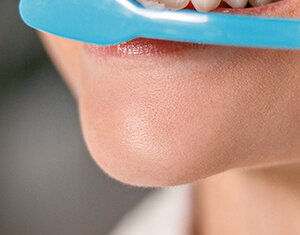Blog
Fluorosis: What It Is, Causes & Treatment
Oral Care

Fluoride is good for teeth, but overexposure causes fluorosis in tooth enamel. Early childhood tooth development is particularly vulnerable. You should identify and reduce sources of excessive fluoride to minimise risk. In this article, we will learn to recognise and manage fluorosis while benefiting from fluoride's decay-preventing advantages.
What is Fluorosis?
Fluorosis is caused by excessive fluoride consumption over time. It affects dental enamel and bone quality. Dental fluorosis happens in children under eight when surplus fluoride impairs enamel formation. High systemic fluoride levels can eventually lead to joint immobility.
Causes of Fluorosis
Fluoride helps dental health, but excessive intake during childhood tooth development can cause fluorosis. Fluoride has a narrow therapeutic index, disrupting enamel mineralisation and bone cell function. So, prudent fluoride levels are crucial.
Water Fluoride Levels
Fluoride levels in municipal water supplies vary based on geological composition. In some areas, fluoride is added to prevent cavities. Overexposure can occur when supplementing with fluoride from food and drink if levels are already high. Check with local water authorities to understand baseline fluoride levels.
Dental Products
It is recommended to use fluorosis toothpaste and rinses with caution to prevent tooth decay. Children under the age of six tend to swallow toothpaste, leading to an excess of fluoride in their system. In order to prevent fluorosis, it's important to use a small amount of paste, introduce fluoride toothpaste only after the child turns three years old, and be mindful of swallowing to avoid any potential risks.
Symptoms and Identification
Excess fluoride leads to physical symptoms that vary. Early detection is crucial. Understand unique fluorosis symptoms for intervention:
Dental Fluorosis
Excess fluoride during tooth development can impair enamel crystal arrangement and cause visible opacity. Mild to severe dental fluorosis can result in discolouration and fragile enamel prone to decay. If not treated cosmetically, it can result in lifelong external discolouration.
Skeletal Fluorosis
High levels of fluoride over time can damage bones and joints, causing stiffness, pain, arthritis, and reduced mobility. Reducing fluoride sources may ease mild symptoms, but severe cases require coordinated management for quality of life.
Treatment and Management
Mild dental fluorosis requires monitoring, while severe cases need treatment to improve smile aesthetics based on age, extent, and dental health.
Approaches to Improve Appearance
- Teeth Whitening: Lightens enamel to blend or mask opaque areas, often with variable efficacy.
- Dental Bonding: Tooth-coloured resin layered onto front surfaces obscures discolouration.
- Veneers: Thin custom-shaped porcelain facades adhere to the fronts of teeth for discrete remodelling.
- Crowns: Fully encase the entire visible tooth for total transformation if whitening proves ineffective; invasive permanent option.
When to Treat
Fluorosis can be treated surgically before the late teens for conservative options. Innovative techniques exist for adult smile refurbishing. Discuss goals with your dentist to determine the optimal approach.
Focus on Prevention Moving Forward
Prevent enamel disturbance with fluoride exposure during developmental years and protect smiles long-term.
Fluorosis Prevention Tips
While various treatment options for moderate fluorosis post-eruption now exist, prevention targeting developing teeth remains most critical for safeguarding children's smiles long-term.
Monitor Fluoride in Drinking Water
Knowing the water's fluoride content at home helps parents adjust for ingested levels. If it exceeds the limit, they can provide an alternative source, filtration, or dilution for young children.
Use Appropriate Toothpaste Amounts
Use a small amount of fluorosis toothpaste for kids under six to avoid overexposure. Dabur Meswak toothpaste is gentle for young children while providing optimal fluoride protection.
Dental Guidance
Regular dental check-ups allow dentists to diagnose and monitor fluorosis, recommend personalised adjustments, and provide early prevention and treatment of fluorosis options. Dentists are important partners in safe fluoride use.
Conclusion
Fluoride prevents cavities, but too much of it can cause tooth and bone issues called fluorosis. To avoid this, monitor childhood fluoride intake, use it in moderation, and get professional guidance. Use Dabur Meswak toothpaste for optimal fluoride levels to prevent cavities and sensitivity while avoiding fluorosis.
FAQs
-
What is dental fluorosis?
Dental fluorosis is a condition that affects the appearance of tooth enamel caused by excessive fluoride intake during early childhood tooth development. It can result in visible discolouration or mottling of teeth.
-
Who is at the highest risk for fluorosis?
Children under age 8 whose permanent teeth are still developing under the gums are at highest risk. Their developing tooth structure incorporates surplus fluoride in a way that disturbs mineralisation and causes enamel defects.
-
Does Dabur Meswak contain fluoride?
Yes, Dabur Meswak contains an optimal amount of fluoride for protecting enamel and combatting sensitivity, decay, and gum problems while avoiding the risk of overexposure.
-
How can you prevent fluorosis?
Prevention involves monitoring total fluoride intake from all sources against the optimum range for your geographic area and judiciously minimising swallowing from dental products like toothpaste until after age 6 when enamel formation completes.
-
Can Dabur Meswak toothpaste help avoid fluorosis?
Yes, Dabur Meswak contains an optimal fluoride concentration to prevent cavities without overexposing children to excess amounts that could risk fluorosis when used as directed.
-
How should fluoride levels be monitored?
Having an awareness of baseline fluoride levels in your local water supply helps monitor total ingestion. Where levels are concerning, provide children with alternative drinking water sources or install water filters to reduce fluoride content.























